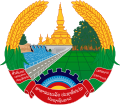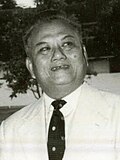| President of the Lao People's Democratic Republic | |
|---|---|
| ປະທານປະເທດ ແຫ່ງ ສປປ ລາວ | |
 | |
 | |
| |
| Style | His Excellency |
| Type | Head of state |
| Member of |
|
| Residence | Presidential Palace, Vientiane |
| Seat | Vientiane |
| Nominator | Lao People's Revolutionary Party |
| Appointer | National Assembly |
| Term length | Five years, renewable once |
| Constituting instrument | Constitution of Laos (1991) |
| Inaugural holder | Souphanouvong |
| Formation | 2 December 1975 |
| Deputy | Vice President |
| Salary | ₭1,170,000 monthly (US$53) [1] |
 |
|---|
The president of the Lao People's Democratic Republic is the head of state of Laos. The current president is Thongloun Sisoulith, since 22 March 2021. He was previously elected as the General Secretary of the Lao People's Revolutionary Party, Laos' most powerful position in January 2021, ranking him first in the Politburo.











